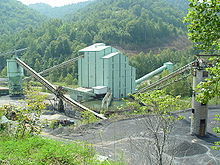Coal washing
The coal washing plant , also known as a wet treatment is a plant for the separation of subsidized coal in different qualities as well as the interfering components ( waste rock , mountains ).
history
The inventor of the process is Ernst Friedrich Wilhelm Lindig , a factor at the Zauckerode Royal Coal Works . In 1810, Lindig made various attempts to reduce the large supplies of lime coal on the river Wiederitz . On September 8, 1810, he was able to report to Carl Wilhelm von Oppel : “... I now think I am so happy to have found this remedy in the well-known, simple preparation work, in setting the sieve, because in this work everything is specific If the heaviness separates, the forged coal remains at the top as the lightest, and the actual lime coal separates itself in the middle, while the mountains partly settle on the ground and partly they pass through the sieve as sludge. ”As early as 1811, bushels of lime coal arrived in 18672 wet processing and were divorced into 4034 bushels of forged coal, 416 bushels of shale coal, 11645 bushels of lime coal and 2577 bushels of mountains. The work consisted of four steps:
- by throwing the extracted lime coals through a sieve
- in choosing the large pieces of slate left behind when thrown through
- in the washing away of the clear debris that fell through the thrown into boxes to separate the types of earth and stone and
- in putting this washed coal through the sieve, whereby forged coal, lime coal and mountains are separated from each other.
The process of wet coal processing established itself in hard coal mining worldwide within a few years. The “washing” soon became one of the largest and most technically complex structures on many shafts.
Procedure
The coal contaminated with mountains is carried into a large water basin. Due to their different densities , coal and mountains separate: the lighter coal floats up and can be drawn off, the heavier rock (the wash mountains ) collects at the bottom of the basin. Impure rock, d. H. Coal that has grown together with the rock is further crushed in a cycle and fed back into the basin until it can be separated into coal and secondary rock in the same way. A flocculant is added to optimize the process .
In the past, the coal was pre-sorted by hand in an additional step on the reading belt. This work was mainly done by women, day boys and disabled miners, in the USA and Great Britain also by so-called "breaker boys".
The effluents of coal washing plant formerly high silt content in the receiving water given where they flooding and pollution of streams led. In order to recover the fine coal, many mines created mud ponds . In times of need, this coal was cut as pond coal, similar to peat, and burned in the coal mine power stations.
The piles of washing are deposited on dumps , used as building material or used as backfill piles for backfilling charred quarries.
literature
- Walter Bischoff , Heinz Bramann, Westfälische Berggewerkschaftskasse Bochum: The small mining dictionary. 7th edition, Verlag Glückauf GmbH, Essen 1988, ISBN 3-7739-0501-7
Individual evidence
- ^ Ernst Friedrich Wilhelm Lindig: Letter to Carl Wilhelm von Oppel regarding the invention of coal washing . In: Mining protocol at the Royal Saxon Coal Works in Plauenschen Grund for the year 1810 . 1810, p. 206 .



